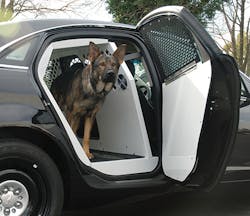In general, police cruisers are just civilian vehicles with some upgrades to things like the electrical system, suspension, engine cooling, and possibly a few other things. Then the dealer, fleet maintenance or an install shop installs the lights, siren, radio, cage, weapon mount(s), etc. A lot of that equipment is pretty straight forward to install. When it comes to outfitting a K9 cruiser, all of the above still gets installed, plus all the specialized canine equipment. Like everything else, budgets play a factor when it comes to outfitting all cruisers. There is some specialized canine equipment that I think all K9 cruisers should have, but I’m sure not all do, and how that equipment is installed can be good or detrimental.
All K9 cruisers should be equipped with a containment unit/insert, and I’m not talking about a couple pieces of plywood screwed into place with a couple of brackets. Besides a makeshift plywood unit looking very unprofessional, it is not safe for the canine in the event of an accident. Metal is stronger and more impact resistant than wood, providing much more protection. Enough said on that subject.
There are two other pieces of equipment that should be in every K9 cruiser. The first is a remote operated door popper, which obviously is for officer safety. The second piece has to do with the primary purpose of this article, heating and cooling. Most of the focus I’ve seen is on making sure our canine doesn’t overheat in the summer months, so we have cooling systems. Those systems or methods vary greatly. For some it may be a matter of partially opening a window and letting the cruiser run with the air conditioning on. Another method is to add a cooling fan to help circulate the cool air.
The best method is to use a temperature monitoring system along with the above methods. Some of these systems are very basic, such as automatically opening a window, turning on a fan and honking the horn to alert you when the inside temperature reaches or exceeds a specified temperature. There are systems that include a belt mounted remote pager that keeps you informed of the temperature and system status via an LCD display and will alert you if temperature is too high. There are also additional sensors such as smoke/carbon monoxide available for some systems. All of this is available for the health and safety of our beloved canine partner.
These systems don’t work just in the summer; they are beneficial in the winter as well. Your canine partner can get overheated just as easy in the winter with that heater blasting on high. If you’re not in the cruiser to be monitoring the temperature, the temperature monitoring systems will be and will do as described above to maintain a safe temperature.
Having a temperature monitoring system is the ideal situation and should be in every K9 cruiser. Depending on the manufacturer, they can run from a few hundred dollars to over a thousand, not including installation. But in the broader scheme of things, it isn’t that much money when you consider the cost of the canine and the cost of training. A canine may get a little sick and not be able to work for a few days, or could go further and have to be retired or buried. Departments invest a lot of money into canines, and a system like this is insurance that those canines will be protected while contained within the cruiser.
The department may spend several thousand dollars on the above specialized equipment, but it is only worth a few dollars if it’s not installed properly and maintained. First off, I hope that the installer isn’t just some run of the mill mechanic giving the department a deal. The installer should know about the equipment they are installing. The equipment should be properly assembled and secured to the vehicle per the manufacturer’s specifications. I don’t think I’ve seen any containment units that didn’t include rear window screens, but they are there to protect the public, the canine and for mounting a fan. With most there should be sufficient space for the fan to be mounted between the window and the screen. The fan is placed there to keep the canine from chewing on it. But it should be mounted and/or wired properly; often, how the wires are connected controls which direction the air flows and an improper installation means more harm than good. When the fan is on, it should be blowing out. This does two things; it exhausts the hot air but also prevents carbon monoxide from entering the vehicle when parked. I have also seen fans mounted on the cage. When mounted in this fashion, they should be on the passenger side of the cage, not canine side, and should be blowing into the canine area. Again, that will keep the canine from chewing on it and will cause the air to be exhausted when the rear window is down. The orientation of the fan is so simple, but can be life threatening if not installed properly.
As the canine handler, you should be checking the equipment and making sure all screws and bolts are tight. It can be as simple as a quick visual inspection and a quick system function test at the beginning of every shift. Do you hear something vibrating that usually isn’t? That is an indicator that something is loose. It could be minor, but what if it isn’t and could cause an issue with something like preventing the door popper from functioning properly. That is bad news for you. If you find an issue, fix it if you can or report it so it can be fixed. Equipment that isn’t properly maintained, is damaged or malfunctioning could cost you your life or your partners. Don’t gamble on it getting you through your shift because it may not.
Stay Safe!

Steven Forgues
Steve Forgues started his career over 18 years ago in Arizona. Over the years, Forgues has worked contract security, police, corrections and tactical operations. Forgues has been an instructor in various disciplines since 1998, and has been working and training with canines since 2000. Forgues has also been writing for law enforcement since 2005. He is currently working as a police officer and firefighter in Pennsylvania.



